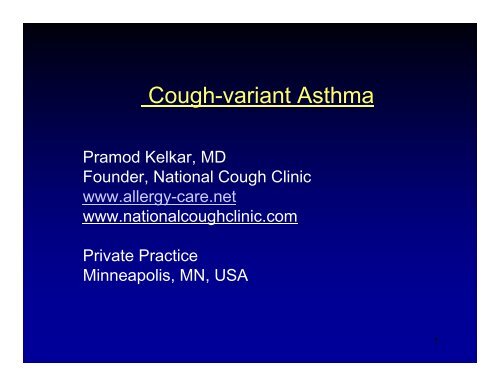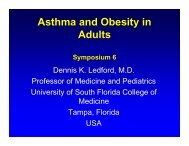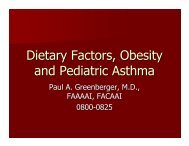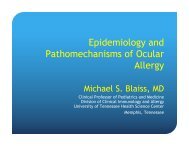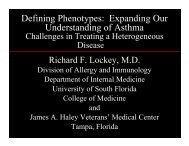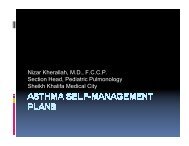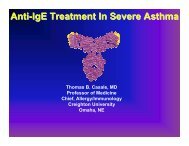cough-variant asthma - Kelkar - World Allergy Organization
cough-variant asthma - Kelkar - World Allergy Organization
cough-variant asthma - Kelkar - World Allergy Organization
Create successful ePaper yourself
Turn your PDF publications into a flip-book with our unique Google optimized e-Paper software.
Cough-<strong>variant</strong> AsthmaPramod <strong>Kelkar</strong>, MDFounder, National Cough Clinicwww.allergy-care.netwww.national<strong>cough</strong>clinic.comPrivate PracticeMinneapolis, MN, USA1
DisclosuresSpeakers’ Bureau• MERCK, Astra-Zeneca, TEVA, MEDA
Eosinophilic bronchitis• NAEB- Non<strong>asthma</strong>tic eosinophilic bronchitis• Cough is the sole symptom• Negative methacholine challenge test• > 3% nonsquamous sputum eosinophils(normal- 1.1%)• Account for about 10-15% cases of chronic<strong>cough</strong>• With or without atopy
Atopic <strong>cough</strong>• Cough as the sole symptom• Atopy• Negative methacholine challenge test• Possibly a sub-group of NAEB• Described in Japanese population
Exhaled Nitric Oxide/eNO• Levels increased in <strong>cough</strong>-<strong>variant</strong> <strong>asthma</strong>and NAEB• Sensitivity and specificity very high (above85%) for predicting response to steroids andpresence of sputum eosinophilia• High negative predictive value to rule outCVA and NAEB before the use of steroids• Very good correlation between eNO andsputum eosinophilia in steroid-naïve patients
Natural history of <strong>cough</strong>-<strong>variant</strong><strong>asthma</strong>• Not entirely clear due to lack ofsufficient data• In one 4-year retrospective study of 42patients, 7 went into remission, and 13developed classical <strong>asthma</strong>Matsumoto H, et al. J Asthma.2006;43(2): 131-5
Natural history of NAEB• In one study of 32 patients, one patienthad complete resolution, 21 (66%) hadpersistent symptoms/inflammation, 3(9%) developed <strong>asthma</strong>, 5 (16%)developed fixed airflow obstruction• Causal association between NAEB andCOPD- ??Berry MA, et al. Clin Exp <strong>Allergy</strong>2005;35(5):598-601
Immunopathology• Mast cells are localized and activated inmore superficial airway epithelium innon<strong>asthma</strong>tic eosinophilic bronchitis,whereas in <strong>asthma</strong> they lie deeper inclose association with the airwaysmooth muscle
Recurrent Cough• What is the likelihood of <strong>asthma</strong> in achild presenting with recurrent <strong>cough</strong>• In a child with <strong>asthma</strong>, is <strong>cough</strong> severitya reflection of <strong>asthma</strong> severity• Recurrent <strong>cough</strong> in the absence ofwheeze is generally not from <strong>asthma</strong>• Children with recurrent <strong>cough</strong> have anincreased <strong>cough</strong> receptor sensitivity tocapsaicin
Treatment of recurrent <strong>cough</strong>• Usually self-limiting• A short therapeutic trial with <strong>asthma</strong>meds can be considered (4 weeks)• If a child doesn’t respond, then avoidescalating treatments but rather take astep back to reassess• Is the child any worse without thetreatment
Cough in an <strong>asthma</strong>tic child• Cough in an <strong>asthma</strong>tic child is often dueto increased <strong>cough</strong> receptor sensitivity• Cough severity may not reflect <strong>asthma</strong>severity• Cough should not be used as the majorindicator for the level of <strong>asthma</strong>treatment especially in an acute episode• Complete absence of <strong>cough</strong> may not beessential for <strong>asthma</strong> control. Avoidovertreatment
Cough-<strong>variant</strong> <strong>asthma</strong>• Over-diagnosed or under-diagnosed??• What do you think???
PatientDeaths(%)Pediatric Asthma Deaths:Patients With Mild Asthma Are Also at Risk4035302520151050Severe Moderate MildPatient AssessmentFindings from a cohort study reviewing all pediatric <strong>asthma</strong>-related deaths(n=51) in the Australian state of Victoria from 1986 to 1989.Robertson et al. Pediatr Pulmonol. 1992;13:95-100.
FEV 1 Is Associated With Risk ofAsthma Attacks80Proportion ofObservationsReporting anAsthma Attack OverSubsequent Year706050403020100Self-reportParental report
Key New Concepts of AsthmaManagement• Elements of assessment and monitoring– Severity– Control– Responsiveness to treatment• Severity emphasized for initiating therapy• Control emphasized for monitoring andadjusting therapy• Severity and control defined in terms of 2domains– Impairment– Riskhttp://www.nhlbi.nih.gov/guidelines/<strong>asthma</strong>/epr3/resource.pdf. Accessed February 5, 2007.
Asthma Severity and Control: Impairment DomainImpairment = Current Frequency and Intensity ofSymptoms and Functional LimitationsSymptoms• Nighttime awakenings• Need for short-actingβ 2-agonists (SABAs) forquick relief of symptoms• School days missed• Exercise toleranceLung Function• Spirometry• Peak flowhttp://www.nhlbi.nih.gov/guidelines/<strong>asthma</strong>/epr3/resource.pdf. Accessed February 5, 2007
Asthma Severity and Control: Risk Domain• Future likelihood of <strong>asthma</strong> exacerbations,progressive decline in lung function over time,or risk of adverse effects from medications• Assessment– Frequency and severity of exacerbations– Prednisone use– ER visits– Lung function– Minimally invasive biomarkers may play anincreased role in the future (NO)Available at: http://www.nhlbi.nih.gov/guidelines/<strong>asthma</strong>/epr3/resource.pdf. Accessed February 5, 2007
Asthma Severity in ChildrenAged 0 to 4 YearsComponents of SeverityImpairmentRiskSymptomsNighttimeawakeningsShort-actingβ 2-agonist use forsymptom control(not prevention ofEIB)Interference withnormal activityExacerbations(considerfrequency andseverity)Intermittent≤2 days/week0≤2 days/weekNone0-1/yearClassification of Asthma SeverityMild>2 days/week butnot daily1-2/month>2 days/week butnot dailyMinor limitationPersistentModerateDaily3-4/monthDailySome limitationSevereThroughout theday>1/weekSeveral times perdayExtremely limited≥2 exacerbations in 6 months requiring oral steroids, or≥4 wheezing episodes/year lasting >1 day AND risk factorsfor persistent <strong>asthma</strong>Frequency and severity may fluctuate over timeExacerbations of any severity may occur in patients in anyseverity category*Currently not taking controller medication.EIB = exercise-induced bronchospasm.Adapted from http://www.nhlbi.nih.gov/guidelines/<strong>asthma</strong>/epr3/resource.pdf. Accessed February 5, 2007.
Asthma Severity: 5 to 11 Years*Components ofSeverityImpairmentRiskSymptomsNighttimeawakeningsShort-acting β 2-agonistuse for symptom control(not prevention of EIB)Interference withnormal activityLung FunctionExacerbations(consider frequencyand severity)Intermittent≤2 days/week≤2/month≤2 days/weekNone• Normal FEV 1betweenexacerbations• FEV 1>80%predicted• FEV 1/FVC>85%0-2/yearClassification of Asthma SeverityMild>2 days/week but notdaily>3-4/month>2 days/week but notdailyMinor limitation• FEV 1 = >80%predicted• FEV 1 /FVC >80%PersistentModerateDaily>1/week but notnightlyDailySome limitation• FEV 1 = 60%-80% predicted• FEV 1 /FVC =75%-80%>2/yearSevereThroughout thedayOften 7/weekSeveral timesper dayExtremelylimited• FEV 1
Key Changes in ClassifyingAsthma Severity in Children• Severity now classified in terms of the newdomains of current impairment and future risk• New measures of impairment– Lung function (FEV 1 /FVC)• New measures of risk– Frequent wheezing episodes and riskfactors for persistent <strong>asthma</strong>– Frequency and severity of exacerbations• “Intermittent” category has replaced “mildintermittent” to emphasize that exacerbationscan be mild or severe
Assessing Asthma Control inChildren Aged 0 to 4 YearsComponents of ControlImpairmentSymptomsNighttime awakeningsInterference withnormal activityShort-actingβ 2 -agonist use forsymptom control (notprevention of EIB)Classification of Asthma ControlNot WellControlledWellControlled≤2 days/week1/monthNone≤2 days/week>2 days/week>1/monthSome limitation>2 days/weekVery PoorlyControlledThroughout the day>1/weekExtremely limitedSeveral times per dayRiskExacerbationsTreatment-relatedadverse effects0-1/year2-3/year>3/yearMedication side effects can vary in intensity from none to very troublesomeand worrisome. The level of intensity does not correlate to specific levelsof control but should be considered in the overall assessment of risk.Adapted from http://www.nhlbi.nih.gov/guidelines/<strong>asthma</strong>/epr3/resource.pdf. Accessed February 5, 2007.
Asthma Control: 5 to 11 YearsComponents of ControlImpairmentSymptomsNighttime awakeningsInterference with normalactivityShort-acting β 2 -agonistuse for symptom control(not prevention of EIB)Lung function• FEV 1 or peak flowFEV 1 /FVC≤2 days/week>80%predicted/personalbest>80% predictedClassification of Asthma ControlNot WellControlledWellControlled≤2 days/week but notmore than once oneach day≤1/monthNone>2 days/week ormultiple times on ≤2days/week≥2/monthSome limitation>2 days/week60%-80%predicted/personalbest75%-80% predictedVery PoorlyControlledThroughout the day≥2/weekExtremely limitedSeveral times per day
Key Changes in AssessingAsthma Control• Once treatment is established, emphasis should beon assessment of <strong>asthma</strong> control rather than onseverity• New measures of impairment– Lung function over time (FEV 1 /FVC)• New measures of risk– Frequency of exacerbations– Treatment-related side effects
Onset of Symptoms in ChildrenWith Asthma 1,220%1–2 Years 30%3 Years1. Wainwright C et al. Med J Aust. 1997;167:218-223.2. Dodge R et al. J <strong>Allergy</strong> Clin Immunol. 1996;98:48-54.
Wheezing Children: Asthma or Not?• 50% of infants who experience a singleepisode of wheezing will present with one ormore additional wheezing episodes within thenext few months 1• 40% of children who wheeze in the first 3years of lifewill continue to wheeze at 6 years of age(“persistent wheezers”) 2• It is important to identify patterns of wheezing andother risk factors for developing <strong>asthma</strong> in children– Early wheezers should be considered for adiagnosis of <strong>asthma</strong> and may, therefore, becandidates for controller therapy
The Risk of Asthma in Wheezing Children:Modified Asthma Predictive Index 1,2In the past 12 months, >3 exacerbations of wheezing with atleast 1 physician-diagnosed exacerbation PLUS1 Major Criterion• Parental history of <strong>asthma</strong>• Physician-diagnosed atopicdermatitis• Allergic sensitization to≥1 aeroallergen*OR2 Minor Criteria• Wheezing unrelated tocolds• Blood eosinophils ≥4%• Allergic sensitization tomilk, eggs, or peanuts*House dust mite, cockroach, dog, cat, mold, grass, tree, and weed.1. Castro-Rodríguez JA et al. Am J Respir Crit Care Med. 2000;162:1403-1406.2. Guilbert TW et al. J <strong>Allergy</strong> Clin Immunol. 2004;114:1282-1287.
Early Aeroallergen Sensitization inChildren Aged 2 to 3 YearsSensitization by Allergen ClassFood 7%Neither 39%Both 26%Aeroallergen 28%–Skin Test = 96 (40%)+Skin Test = 145 (60%)Study included 285 children, aged 2 to 3 years, with positive modified Asthma Predictive Index (mAPI).Adapted with permission from Guilbert TW et al. J <strong>Allergy</strong> Clin Immunol. 2004;114:1282-1287.
Epithelial Remodelling in AsthmaNormalAsthmatic
Effect of Inhaled Budesonideon InflammationE = EpitheliumBM = BasementMembranePre– and post–3-month tx with budesonide (BUD) 600 mcgb.i.d.Laitinen et al. J <strong>Allergy</strong> Clin Immunol. 1992;90:32-42.
Risk factors for developing<strong>asthma</strong>• Family history of <strong>asthma</strong>/atopy• Sensitization to indoor allergens: dustmites, animal dander, cockroaches• Sensitization to outdoor allergens: e.g.Alternaria• Early exposure to cigarette smoke• Rhinitis
Many Patients Incorrectly Perceive TheirAsthma as “Well/Completely” Controlled 1,2Percentage of Patients WhoConsider Their Asthma“Well/Completely” Controlled70605040302010060%Moderate(n=473)• Daily daytime symptoms• Nighttime symptoms>1 night/week32%Severe(n=480)• Continual daytime symptoms• Frequent nighttimesymptoms1. Adapted with permission from Chipps BE, Spahn JD. J Asthma. 2006;43:567-572.2. Asthma in America Survey. Executive Summary. Available at: http//:www.<strong>asthma</strong>inamerica.com. Accessed December 4, 2006.
The Rule of “2”Daytime <strong>asthma</strong> symptomsNighttime <strong>asthma</strong> symptomsRescue β 2 -agonist canistersRescue β 2 -agonist use>2 days per week>2 days per month>2 per year>2 times per week1. United States Environmental Protection Agency. Asthma facts. Available at: http://www.epa.gov/<strong>asthma</strong>/pdfs/<strong>asthma</strong>_fact_sheet_en.pdf. AccessedFebruary 6, 2007. 2. Children and <strong>asthma</strong> in America. Asthma in America Web site. Available at: http://www.<strong>asthma</strong>inamerica.com/acute.html. AccessedJanuary 22, 2007. 3. United States Department of Health and Human Services. National Center for Health Statistics Web site. Available at:http://www.cdc.gov/nchs/hus.htm. Accessed March 5, 2007. 4. Carlton BG, Lucas DO, Ellis EF, et al. The status of <strong>asthma</strong> control and <strong>asthma</strong> prescribingpractices in the United States: results of a large prospective <strong>asthma</strong> control survey of primary care practices. J Asthma. 2005;42:529-535. 5. NationalInstitutes of Health. National Asthma Education and Prevention Program Expert Panel Report: Guidelines for the Diagnosis and Management of Asthma—Update on Selected Topics 2002. Available at: http://www.nhlbi.nih.gov/guidelines/<strong>asthma</strong>/asthsumm.htm. Accessed February 6, 2007.
Exploring Reasons for Failureof Asthma Control 1,2• “Under or Mis” diagnosis of <strong>asthma</strong>• Inadequate therapy for disease severity• Not addressing environmental allergies• Poor compliance• Repeated respiratory infection (daycare)• Comorbid conditions: Sinus, GERD1. Joint Task Force on Practice Parameters. J <strong>Allergy</strong> Clin Immunol. 2005;116:S3-S11.2. National Asthma Education and Prevention Program. Expert Panel Report 2: Guidelines for the Diagnosis and Management of Asthma.National Heart, Lung, and Blood Institute, National Institutes of Health; July 1997. NIH publication 97-4051.
Assessment of Asthma ControlRecommended (1- to 6-Month Intervals) Are goals of therapy being met? Are adjustments in treatment necessary? Measure Signs and symptoms Pulmonary function Quality of life (QOL)/functional status History of exacerbations Pharmacotherapy Patient-provider communication andpatient satisfaction
Asthma Action Plan until ______________WrittenAsthmaActionPlanNamePrimary Care Provider Name:Daytime Phone Number:Night/Weekend Phone Number:Pharmacy NamePharmacy Phone Number:DateThe colors of a traffic light will help youuse your <strong>asthma</strong> medicines.Green means Go Zone!Use preventive medicine.Yellow means Caution Zone!Add quick-relief medicine.Red means Stop Zone!Get help from a doctor.Personal Best Peak Flow: ________GO ACTION: Use these daily preventive anti-inflammatory medicines:You have all of these:• Breathing is good• No <strong>cough</strong> or wheeze• Sleep through theNight• Can work and playFor <strong>asthma</strong> withexercise, take:Medicine How Much How OftenCAUTION ACTION: Continue with your medicine, as above, and ADD:You have any of these:• First signs of a cold• Cough• Mild wheeze• Tight chestPeak flowfrom________to________Peak flowfrom________to________Medicine How Much How OftenCall your primary care providerDANGER ACTION: Take these medicines until you talk to your doctor:Get help from a doctor now! Do not be afraid of causing a fuss.Your doctor will want to see you right away. It’s important!Your <strong>asthma</strong> is getting worse fast:• Medicine is not helping• Breathing ishard and fastPeak flowbelow• Nose opens wide________• Ribs show• Can’t talk wellMedicine How Much How OftenIf you cannot contact your doctor, go directly to the emergency room. DO NOT WAIT.Call an ambulance (911) if necessary.Make an appointment with your primary care provider within two days of an ER visit or hospitalization.Adapted from the NHLBIReprinted with permission from IMPACT DC.
Clinical Control of Asthma No (or minimal)* daytime symptoms No limitations of activity No nocturnal symptoms No (or minimal) need for rescue medication Normal lung function No exacerbations_________* Minimal = twice or less per week
Key Questions• Are Peak Flow Meters useful?• When to give Asthma Action Plans?• When and why to do allergy testing?• Can starting early on inhaled steroidsprevent airway remodeling?• What is the role of allergy shots?• Can allergy shots prevent <strong>asthma</strong>?
Primary Prevention of Asthma??• Hygiene hypothesis- early exposure toendotoxins, microbial products• Exposure to farm livestock, farm milk• Breast feeding• Early pet exposure• <strong>Allergy</strong> immunotherapy/allergy shots
Can you outgrow <strong>asthma</strong>?• 10-39% remission rate in children withnon-atopic <strong>asthma</strong>
Inhaled steroids and Growth• Relatively safe at low doses but havethe potential to cause growth effects• Use lowest dose possible• Monitor growth charts• Individualize the treatment• Avoid steroid phobia and don’t be toocasual either!
Don’t forget to address• Environmental allergies• Pet exposures• Reflux• Sinusitis• Obesity• Parental smoking• Compliance on meds
Stepwise Approach for Managing Asthmain Children Aged 0 to 4 YearsIntermittentPersistent Asthma: Daily MedicationStep 1Preferred:SABA prnStep 2Preferred:Low-Dose ICSAlternative:MontelukastorCromolynStep 3Preferred:Medium-Dose ICSStep 4Preferred:Medium-DoseICSand eitherMontelukastorLABAStep 5Preferred:High-DoseICSand eitherMontelukastorLABAStep 6Preferred:High-Dose ICSand eitherMontelukastorLABAandOralCorticosteroidsStep Up ifNeeded(first, checkadherence andenvironmentalcontrol)AssessControlStep Down ifPossible(and <strong>asthma</strong> iswell controlledat least 3months)Patient Education and Environmental Control at Each StepICS = inhaled corticosteroid; LABA = long-acting β 2-agonist; SABA = short-acting β 2-agonist.Adapted from http://www.nhlbi.nih.gov/guidelines/<strong>asthma</strong>/epr3/resource.pdf. Accessed February 5, 2007.
Stepwise Approach for Managing Asthmain Children Aged 5 to 11 YearsIntermittentPersistent Asthma: Daily MedicationStep 1Preferred:SABA prnStep 2Preferred:Low-Dose ICSAlternative:LTRA,Cromolyn,Nedocromil,orTheophyllineStep 3Preferred:Medium-DoseICSorLow-Dose ICSand eitherLABA, LTRA,orTheophyllineStep 4Preferred:Medium-DoseICS + LABAAlternative:Medium-DoseICSand eitherLTRAorTheophyllineStep 5Preferred:High-DoseICS + LABAAlternative:High-DoseICSand eitherLTRA orTheophyllineandOmalizumabMay BeConsideredFor PatientsWho HaveAllergiesStep 6Preferred:High-Dose ICS+ LABA + OralCorticosteroidAlternative:High-Dose ICSand eitherLTRA orTheophylline +OralCorticosteroidandOmalizumabMay BeConsidered ForPatients WhoHave AllergiesStep Up ifNeeded(first, checkadherence andenvironmentalcontrol)AssessControlStep Down ifPossible(and <strong>asthma</strong> iswell controlledat least 3months)Patient Education and Environmental Control at Each StepLTRA = leukotriene receptor antagonist.Adapted from http://www.nhlbi.nih.gov/guidelines/<strong>asthma</strong>/epr3/resource.pdf. Accessed February 5, 2007.
IntermittentAsthmaPersistent Asthma: Daily MedicationConsult with <strong>asthma</strong> specialist if step 4 care or higher is required.Consider consultation at step 3.Step 1Preferred:SABA PRNStep 2Preferred:Low-dose ICSAlternative:Cromolyn,Nedocromil,LTRA, orTheophyllineStep 3Preferred:Medium-doseICSORLow-doseICS + LABAAlternative:Low-dose ICS +either LTRA,Theophylline,or ZileutonStep 5Preferred:High-doseICS + LABAANDConsiderOmalizumab forpatients whohave allergiesPatient Education and Environmental Control at Each StepQuick-Relief Medication for All PatientsStep 4Preferred:Medium-doseICS + LABAAlternative:Medium-doseICS + eitherLTRA,Theophylline,or ZileutonStep 6Preferred:High-doseICS + LABA +oralcorticosteroidANDConsiderOmalizumab forpatients whohave allergiesStep up ifneeded(first, checkadherence,environmentalcontrol, andcomorbidconditions)AssesscontrolStep down ifpossible(and <strong>asthma</strong> iswell controlledat least3 months)• SABA as needed for symptoms. Intensity of treatment depends on severity of symptoms: up to 3 treatments at 20-minuteintervals as needed. Short course of systemic oral corticosteroids may be needed.• Use of beta 2-agonist >2 days a week for symptom control (not prevention of EIB) indicates inadequate control and the need tostep up treatment.
Inhaled Steroids Target MultipleInflammatory Mediators 1-3Inflammatory SignalTransduction MoleculesNOS, COX, PLALeukotrienes ?CorticosteroidsProstaglandinsCytokinesAdhesion MoleculesCOX = cyclooxygenase; NOS = nitric oxide synthase; PLA = phospholipase A.1. Barnes PJ. Eur J Pharmacol. 2006;533:2-14.2. Barnes PJ et al. Am J Respir Crit Care Med. 1998;157:S1-S53.3. O’Shaughnessy KM et al. Am Rev Respir Dis. 1993;147:1472-1476.
Key RecommendationsManaging <strong>asthma</strong> in children 0-4 years• Diagnosis is often difficult.• Treatment has not been adequately studied.• Criteria for initiation of long-term-control therapy:− 3 wheezing episodes in past year and positive<strong>asthma</strong> risk profile.− those who require symptomatic treatment> 2 days per week− two or more severe exacerbations within6 monthsDRAFT NHLBI 2007
The Risk of Asthma in Wheezing Children:Modified Asthma Predictive Index 1,2In the past 12 months, >3 exacerbations of wheezing with atleast 1 physician-diagnosed exacerbation PLUS1 Major Criterion• Parental history of <strong>asthma</strong>• Physician-diagnosed atopicdermatitis• Allergic sensitization to≥1 aeroallergen*OR2 Minor Criteria• Wheezing unrelated tocolds• Blood eosinophils ≥4%• Allergic sensitization tomilk, eggs, or peanuts*House dust mite, cockroach, dog, cat, mold, grass, tree, and weed.1. Castro-Rodríguez JA et al. Am J Respir Crit Care Med. 2000;162:1403-1406.2. Guilbert TW et al. J <strong>Allergy</strong> Clin Immunol. 2004;114:1282-1287.
Estimate Comparative Daily Dosages forInhaled Glucocorticosteroids by AgeDrugLow Daily Dose (µg) Medium Daily Dose (µg) High Daily Dose (µg)> 5 y Age < 5 y > 5 y Age < 5 y > 5 y Age < 5 yBeclomethasone 200-500 100-200 >500-1000 >200-400 >1000 >400Budesonide 200-600 100-200 600-1000 >200-400 >1000 >400Budesonide-NebInhalation Suspension250-500 >500-1000 >1000Ciclesonide 80 – 160 80-160 >160-320 >160-320 >320-1280 >320Flunisolide 500-1000 500-750 >1000-2000 >750-1250 >2000 >1250Fluticasone 100-250 100-200 >250-500 >200-500 >500 >500Mometasone furoate 200-400 100-200 > 400-800 >200-400 >800-1200 >400Triamcinoloneacetonide400-1000 400-800 >1000-2000 >800-1200 >2000 >1200
Follow-Up• Visits every 2-6 weeks until control achieved• When control achieved, contact every 3-6months• Step-down in therapy– Consider with well-controlled <strong>asthma</strong> for atleast 3 months– Decrease inhaled steroids by 25-50 % every3 months to lowest effective dose– Patients may relapse with totaldiscontinuation of inhaled corticosteroids
Peak Flow Meter is optional!• Maximum expiratory flow rate• Helps in monitoring (Not diagnosis)• Very effort dependent• Poor at detecting early/ mild obstruction• Can not distinguish between obstructionand restrictionDe-emphasize!
What can lead to “difficult-to-control”<strong>asthma</strong>?• Wrong diagnosis (VCD, FB, CF, others)• Missed/untreated co-morbidities (Allergies)• Heterogeneity of <strong>asthma</strong>• Wrong medicine:- Technique- Choice- Dose• Patient factors: compliance, anxiety, obesity
Pharmacotherapy for Asthma• Short-acting beta agonists: albuterol, Maxairautohaler, Xopenex• Long-acting beta agonists (LABA): Serevent, Foradil• Inhaled steroids: fluticasone (Flovent), budesonide(Pulmicort), Asmanex (mometasone), Q-Var,Azmacort, Ciclesonide• Inhaled steroid/LABA combination: Advair, Symbicort,Dulera• Leukotriene modifiers: Singulair, Accolate• Leukotriene inhibitor: Zileuton (zyflo)• Anti-IgE: Xolair• Miscellaneous: Theophylline, lidocaine via nebulizer• Oral steroids: prednisone• <strong>Allergy</strong> Immunotherapy/Injections
Can diet affect respiratory system???• Fruit-based (apples, pears, etc.) dietaryfiber intake reduced <strong>cough</strong> with phlegm (?)• Omega-3 fatty acid play a role inleukotrienes and inflammation (?)• Vitamin C for exercise-induced <strong>asthma</strong> (?)• Whole grains and fish lower <strong>asthma</strong> risk (?)Butler LM, et al. Am J Respir and Crit Care Med2004;170: 279-287Cohen HA, et al. Blocking effect of vitamin C inexercise-induced <strong>asthma</strong>. Arch Pediatr Adolesc.Med 1997;151:367-70Tabak C, et al. Diet and <strong>asthma</strong> in Dutch schoolchildren. Thorax. 2006;61:1048-1053
My vision for a futuristic <strong>asthma</strong> caremodelCollaboration• Patient• Nurse• Respiratory therapist• Pharmacist• Dietician and Exercise Therapist, Counselling• Primary Care Provider and Specialist• AAAAI, ACAAI: Web-based educationalsupport, CME, CE
Bibliography(1) Ramanuja S, <strong>Kelkar</strong> P. Ann <strong>Allergy</strong> AsthmaImmunol. 2009 Feb;102(2):91-5; quiz 95-7,115.(2) Rank MA, <strong>Kelkar</strong> PS, Oppenheimer JJ. Ann<strong>Allergy</strong> Asthma Immunol. 2007;98:305-313(3) Morice AH. ERJ 2004;24:481-492 (European)(4) Irwin RS, et al. Chest 2006;129 (American)(4) Morice AH, McGarvey L, Pavord I. Thorax2006; 61:suppl 1 (British)
Bibliography continued…• Ramanuja V, <strong>Kelkar</strong> P. Pediatric Cough.Annals of <strong>Allergy</strong> Asthma andImmunology 2010;105(1):3-8• Goldsobel A, Chipps B. Cough in thepediatric population. The Journal ofPediatrics 2010;156(3): 352-358• Chang AB. Cough guidelines forchildren : can its use improveoutcomes. Chest 2008;134:1111-1112
Thank you!Pramod <strong>Kelkar</strong>, MDFounder, National Cough ClinicPast Co-Chair, Metro Asthma CoalitionPrivate PracticeMinneapolis, MN, USAwww.allergy-care.netwww.national<strong>cough</strong>clinic.com1


